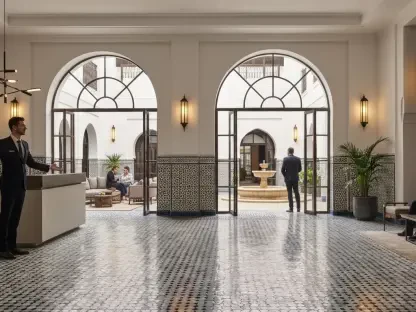In a bold step toward redefining eco-tourism, a visionary project has emerged near Lake Burley Griffin in Canberra, Australia, aiming to attract affluent travelers with an unparalleled blend of luxury and nature, while setting a new standard for sustainable accommodations. This innovative proposal by Eco Suites Australia seeks to install glass geodesic domes at Yarramundi Reach, offering a high-end glamping experience that promises both indulgence and sustainability. With a focus on off-grid living and minimal environmental impact, the initiative could set a new benchmark for nature-based accommodations. The plan not only caters to those seeking premium retreats but also emphasizes cultural immersion through partnerships with the local Ngunnawal people. As public consultation unfolds, this venture sparks curiosity about how luxury tourism can harmonize with ecological and community values, potentially transforming an underutilized lakeside area into a sought-after destination for discerning visitors from around the globe.
Innovative Design and Sustainable Features
The heart of this eco-tourism venture lies in the design of the proposed geodesic domes, each spanning 30 square meters and crafted to rival the opulence of a five-star hotel. These structures are envisioned as self-contained havens, complete with king-size beds, reverse-cycle air conditioning, private ensuite bathrooms featuring walk-in showers, and modern amenities like Wi-Fi and wall-mounted TVs. Unique touches such as remote-controlled windows and retractable roofs elevate the experience by allowing guests to stargaze from the comfort of their beds. Privacy is ensured through opaque glass panels with blue UV film, designed to blend seamlessly into the natural surroundings. Beyond aesthetics, sustainability drives the project, with solar arrays, battery storage, and backup generators powering the domes, alongside a 10,000-liter potable water tank and advanced waste storage systems, ensuring an off-grid operation that prioritizes environmental responsibility.
Further enhancing the appeal of these domes is the meticulous attention to their integration into the lakeside setting without compromising on luxury or ecological balance. Safety and convenience are addressed through features like 24-hour concierge service, CCTV surveillance, and private security patrols, guaranteeing peace of mind for guests. The environmental commitment extends to the construction phase, with a pledge to avoid removing established trees while planning to replant native species for any vegetation cleared, in collaboration with local authorities. This approach reflects a broader vision of creating a retreat that not only pampers its visitors but also respects and preserves the natural beauty of Yarramundi Reach. The balance struck between high-end comfort and eco-conscious design could serve as a model for future tourism developments, showcasing how innovation can align with stewardship of the environment in unique and meaningful ways.
Strategic Location and Infrastructure Plans
Nestled at Yarramundi Reach near the Yarramundi Cultural Centre, the chosen location for this glamping project offers a secluded escape with minimal light pollution, ideal for a tranquil retreat by Lake Burley Griffin. The site’s natural allure is complemented by thoughtful infrastructure plans, including timber decks to support the domes, a dedicated car park, and granite paths for easy access. Secure entry through an automated gate off Lady Denman Drive ensures privacy, while traffic impact remains low with an expected maximum of four to five vehicles at any given time. This strategic positioning not only enhances the guest experience by immersing them in serene surroundings but also aims to activate an underutilized area without encroaching on public access to the shoreline or nearby cycle paths, maintaining harmony with the community’s existing use of the space.
Beyond the immediate site, the infrastructure design underscores a commitment to minimal disruption during both construction and operation phases. The project timeline includes a 16-week construction period followed by an eight-week fit-out and testing phase, targeting a launch in the first half of next year. Public consultation on the proposal, currently open until late November, provides an opportunity for community input to shape the final implementation. By prioritizing low-impact development and ensuring that facilities blend into the landscape, the initiative seeks to preserve the area’s natural charm while introducing a new dimension of tourism. This careful planning highlights how strategic site selection and infrastructure can work hand in hand to create a destination that benefits both visitors and the local environment, setting a precedent for thoughtful eco-tourism projects.
Economic and Cultural Impact
Economically, this glamping venture holds significant promise for the Australian Capital Territory, with projections estimating around 8,100 visitors over the next five years, contributing approximately $4.4 million through 4,000 overnight stays. This influx of affluent tourists is expected to bolster local businesses and create new opportunities in an area that has remained largely untapped for such developments. The focus on high-end travel ensures that the economic benefits are substantial, positioning Canberra as a unique destination for luxury eco-tourism on a global stage. Importantly, the project avoids restricting public access to surrounding amenities, aiming for a low community impact while still driving economic growth through targeted activation of the lakeside region, demonstrating a model where tourism and local interests can coexist.
Culturally, the proposal stands out for its commitment to collaboration with the Ngunnawal people, the region’s Indigenous community, to weave authentic cultural experiences into the guest offerings. This partnership aims to provide visitors with a deeper understanding of the area’s heritage, enriching their stay beyond mere luxury. By integrating these elements, the project not only offers a unique selling point but also fosters respect and recognition for local traditions. This cultural dimension adds layers of value to the glamping experience, ensuring it resonates on a meaningful level with travelers seeking more than just a scenic getaway. As the initiative moves through its planning stages, it becomes clear that balancing economic gains with cultural sensitivity is a priority, reflecting a forward-thinking approach that could inspire similar ventures to prioritize community engagement alongside financial objectives.









